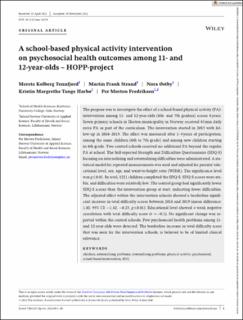| dc.contributor.author | Tennfjord, Merete Kolberg | |
| dc.contributor.author | Strand, Martin Frank | |
| dc.contributor.author | Østby, Nora | |
| dc.contributor.author | Harbø, Kristin Margrethe Tange | |
| dc.contributor.author | Fredriksen, Per Morten | |
| dc.date.accessioned | 2023-03-02T08:27:07Z | |
| dc.date.available | 2023-03-02T08:27:07Z | |
| dc.date.created | 2022-12-13T08:58:17Z | |
| dc.date.issued | 2022 | |
| dc.identifier.citation | Scand J Med Sci Sports. 2022. | en_US |
| dc.identifier.issn | 0905-7188 | |
| dc.identifier.uri | https://hdl.handle.net/11250/3055175 | |
| dc.description.abstract | The purpose was to investigate the effect of a school-based physical activity (PA)-intervention among 11- and 12-year-olds (6th- and 7th graders) across 4 years. Seven primary schools in Horten municipality in Norway received 45 min daily extra PA as part of the curriculum. The intervention started in 2015 with follow-up in 2016–2019. The effect was measured after 1–4 years of participation, among the same children (6th to 7th grade) and among new children starting in 6th grade. Two control schools received no additional PA beyond the regular PA at school. The Self-reported Strength and Difficulties Questionnaire (SDQ-S) focusing on internalizing and externalizing difficulties were administrated. A statistical model for repeated measurements was used and adjusted for parents' educational level, sex, age, and waist-to-height ratio (WHtR). The significance level was p ≤ 0.01. In total, 1221 children completed the SDQ-S. SDQ-S scores were stable, and difficulties were relatively low. The control group had significantly lower SDQ-S scores than the intervention group at start, indicating fewer difficulties. The adjusted effect within the intervention schools showed a borderline significant increase in total difficulty scores between 2018 and 2019 (mean difference: 1.02, 95% CI: −1.82, −0.23, p ≤ 0.01). Educational level showed a weak negative correlation with total difficulty score (r = −0.1). No significant change was reported within the control schools. Few psychosocial health problems among 11- and 12-year-olds were detected. The borderline increase in total difficulty score that was seen for the intervention schools, is believed to be of limited clinical relevance. | en_US |
| dc.language.iso | eng | en_US |
| dc.rights | Attribution-NonCommercial-NoDerivatives 4.0 Internasjonal | * |
| dc.rights.uri | http://creativecommons.org/licenses/by-nc-nd/4.0/deed.no | * |
| dc.subject | physical activity | en_US |
| dc.subject | fysisk aktivitet | en_US |
| dc.subject | barn | en_US |
| dc.subject | children | en_US |
| dc.subject | school | en_US |
| dc.subject | skole | en_US |
| dc.title | A school-based physical activity intervention on psychosocial health outcomes among 11- and 12-year-olds – HOPP-project | en_US |
| dc.title.alternative | A school-based physical activity intervention on psychosocial health outcomes among 11- and 12-year-olds – HOPP-project | en_US |
| dc.type | Peer reviewed | en_US |
| dc.type | Journal article | en_US |
| dc.description.version | publishedVersion | en_US |
| dc.source.journal | Scandinavian Journal of Medicine & Science in Sports | en_US |
| dc.identifier.doi | 10.1111/sms.14278 | |
| dc.identifier.cristin | 2092332 | |
| cristin.ispublished | true | |
| cristin.fulltext | original | |
| cristin.qualitycode | 2 | |

